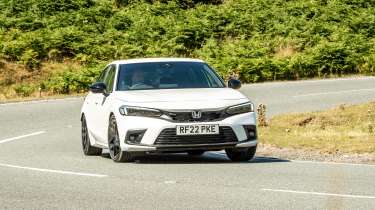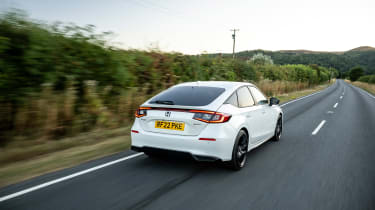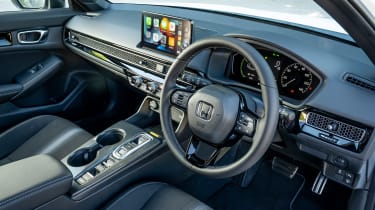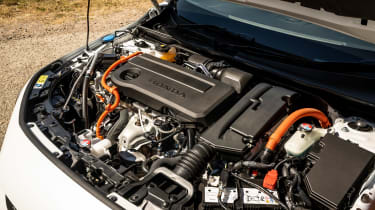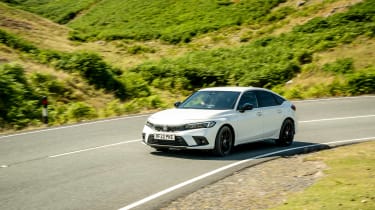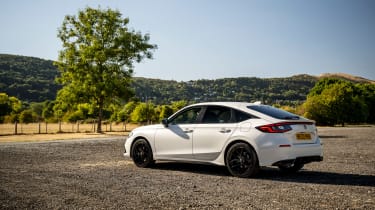Honda Civic e:hev Sport 2022 review – is there any Type R DNA inside?
Honda’s precision engineering has been applied to its mainstream Civic, making it an extremely good sign for the incoming FL5 Type R
With every new Type R there has to be a new Honda Civic to base it on, so before we experience the upcoming FL5 this is a great chance to get a sneak preview of what might be to come. Available in the UK in three trims with a single hybrid powertrain, the new Civic will need to stand out from a crowd of its mainstream rivals that include the Toyota Corolla, Ford Focus, Peugeot 308 and Volkswagen Golf, and thanks to a starting price close to £30,000, premium rivals such as the Audi A3, BMW 1-series and Mercedes A-class too.
The good news is that like the last model, the standard Civic has been designed down from the new Type R, meaning all its inherent structural advantages have been carried across, too. The Civic is the longest, widest and lowest hatchback in the class, and key revisions to its chassis and structure – including its use of nine times more adhesive – have made it 22 per cent stiffer, more than the previous-generation Type R, in fact.
This, plus key revisions to the front and rear suspension, including stiffening the suspension mounting points and maintaining the previous car’s multi-link rear axle, means no basic Civic has ever been so, well, un-basic. This is reiterated the instant you open the door, as the interior and overall quality is far higher than was the case with the previous model, from the sound of the door shut to the standard of the interior’s fixtures and fittings.
The new cabin is very sophisticated for a C-segment hatchback, as while it lacks the design flare of the new 308, and high-tech minimalism of the latest Golf, the straight-laced dash and control layout actually works from an ergonomic perspective – it is so refreshing getting into a modern car and finding rotary controls for things such as the volume and temperature control, and this coming from a millennial…
More reviews
Of even more importance are the basic seating position and visibility, both of which are significantly better than almost all rivals. The seating position is particularly good, and will only get better for the Type R with its removal of the electric adjustments and a thinner seat base. While the Civic’s overall structure is similar to before, Honda has pulled the A-pillars back and closer to the driver, improving corner visibility – all basic stuff that seems to be disregarded more and more by C-segment hatchbacks.
The powertrain has its curiosities but all in the pursuit of efficiency, which for this segment is an important factor. All models use Honda’s clever e:hev hybrid powertrain that works like the system in the Jazz and HR-V, but scaled up with two larger electric motors, joined by a 2-litre naturally aspirated four-cylinder engine. Power figures are bang-on with those of higher-specification rivals, with a peak power figure of 181bhp and 232lb ft of torque. The latter figure specifically might feel a little bit thin, but because the torque is generated from zero rpm, it actually feels more potent than you’d expect. The IC on its own is able to produce a maximum output of 141bhp, but as this power doesn’t drive the wheels (mostly), it’s the electric motor’s 181bhp figure that’s the relevant one here.
Despite Honda’s eCVT naming convention for the transmission, there’s actually no physical gearbox, instead in most driving scenarios it’s the electric motors that solely drive the wheels. The two work in conjunction with one another – one acting as a generator and the other as the main power unit, with voltage to both generated by the petrol engine according to throttle input. There is a battery involved, but it’s a tiny 1.05kWh-capacity unit and weighs just 36kg. It’s not designed to run the electric motors on its own at high speeds, nor can it be charged independently.
What does this all feel like on the road? It essentially drives like an EV, with a largely distant 2-litre petrol engine whirring away somewhere behind the dashboard. On paper, the Civic will accelerate to 62mph in 7.8sec, a figure that actually feels a little bit conservative given its relatively impressive rate of acceleration in the real world. Put your foot flat on the throttle and the engine will wake right up, but to stop any rev-flare Honda’s put in subtle steps that give the impression of gearchanges. It sounds a bit rubbish, but does work.
It’s when settled into a high-speed cruise on motorways that the petrol engine will couple to the front wheels with a direct drive system, because this is when the efficiency curves between an electric and combustion motor cross over. If you need to call for a burst of acceleration, the engine will decouple and the electric motors will provide the grunt you need.
Chances are, though, you’re reading this disregarding the powertrain and wondering what it’ll mean for the new Type R’s chassis, and first impressions are good. The Civic feels stiff and solid; if anything it’s gone a little too far for the everyday driver. The suspension tune on the 18-inch wheels and Michelin PS4 tyres fitted to all but the base-level car is surprisingly firm, giving it impressive lateral control and stability, but to the detriment of day-to-day ride quality. The steering is very accurate and very precise – perhaps a little heavier than you’d expect – and feedback is good, especially in comparison to its main rivals.
Overall chassis balance is very impressive, too. There’s little in terms of front-end push, and the rear end is actually very neutral, but not to the point that it’ll get out of shape or need to lean into the stability control. Crucially, everything feels honed - typical of Honda’s penchant for exacting engineering.
At this point, it’s impossible to ignore the fact the powertrain does let the side down a tad, but like a new BMW 220i coupe or the basic Porsche 718 Cayman, the base Civic portrays a strong basis for something far more potent coming further down the line. It looks more resolved than before, has a big jump in quality, drives extremely well and has all the performance you could reasonably want paired with an impressive set of economy figures (up to 60mpg). Save for a firm ride and some higher-than-average levels of road noise (that’ll be the PS4s), it’s an impressive package.
Prices and rivals
If you’ve not been keeping tabs on the prices of real cars in the last 12 months, you might be shocked to know the reality of any basic C-segment hatchback costing from around £20k is long gone. Honda’s brought over three trims, with the basic Elegance model starting at £29,595. For this, you’ll get plenty of kit including LED lighting, front and rear parking sensors, a rear parking camera, 17-inch wheels, heated front seats and the full digital interfaces that include a nine-inch touchscreen on the dash and a part-digital dial pack.
Sport models are only £1000 more at £30,595, pick up 18-inch wheels and Michelin PS4 rubber, part-synthetic leather seats, a bunch of sportier styling elements and wireless charging for your phone. The £32,995 top-spec Advance throws in the kitchen sink with Matrix LED headlights, a large sunroof, full 10.2-inch instrument cluster, BOSE sound system, electronically operated leather seats, heated steering wheel – we could go on. It’s enough to force you to choose the highest-spec premium rival and most option packs to match it.
Run down the price lists of main rivals and you’ll note they all start at around £30k, but with less performance and less kit. An A-class or A3 will set you back around £32,000, but you’ll need to deal with just 150bhp-ish and a big cut in standard equipment. A BMW 118i M Sport is a similar story, but you’ll save £1000, but then lose a further 16bhp. Try to search up a Focus and right now things look tricky, with Ford prioritising production of its SUVs until it gets a handle on its chip supply.
As such, the Civic’s main mainstream rivals for now include the Golf, 308 and Corolla. In which case, the Golf is both less well equipped and more expensive, the 308 a bit undernourished under the bonnet and the Corolla remains the one model bucking Toyota’s trend of creating stimulating driver’s cars. A wild card is the Mazda 3 hatchback – yet despite the great manual transmission, its chassis is a little soggy, and the Skyactiv-X variable-ignition petrol engine still has some rough edges to its power delivery.
So if you need a C-seg runaround the Civic’s a very good bet, and if you're just waiting for the next Type R then consider this a very good sign.

